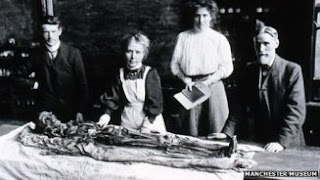https://ancientegyptbiobank.wordpress.com/2016/02/04/whos-coming-to-a-mummy-re-rolling/
Who's coming to a mummy 're-rolling'?
Mummy unwrapping 'spectacles' were a popular pastime in the nineteenth century with mummies brought back from Egypt as souvenirs by travellers providing the majority of the candidates. These events were as much a spectacle, a Victorian socialite pastime, but as time wore on, the studies became increasingly linked to the people behind the mummies and the science behind the embalming process.
On June 10th, 1850, Lord Londesborough issued a now infamous invitation to witness the 'unrolling' of a human mummy from Thebes 'at half past two'. A spectacle which was to take place at his home, in the comfort of his drawing room, no doubt with a glass of claret in hand. This invitation epitomises an 'un-rolling' event. Delving into the bandages, cutting through the layers of linen, to reveal the person within. Yet the vast majority of Lord Londesborough's invitees were members of the Royal Society of Antiquaries, a prestigious gathering of learned gentlemen, relatively well-versed in the ways of human anatomy. By all accounts, not your normal socialites!
Manchester has it's own history when it comes to mummy un-rollings. In 1908, Margaret Murray unwrapped the mummified bodies of Nekht-Ankh and Khnum-Nakht – known as the Two Brothers – at Manchester Museum. In 1975, Rosalie David, Director of the Manchester Mummy Project unwrapped the mummy known affectionately by her accession number, Mummy 1770. Both unwrappings involved an interdisciplinary team of specialists tasked with investigating the life and death of these ancient people.
Fast forward to 2016 and museums ethics have changed massively. Unwrapping is not considered ethical viable and thankfully we have many methods at our disposal to deploy when investigating mummified remains, whether they be human or animal. Science has given us the ability to see what lies beneath the wrappings of a mummy without needing to physically remove any wrappings.
Recently, we've been asked to design an event for an After Hours event for adults at Manchester Museum. We decided it would be good to 'reverse' some of the negative connotations surrounding unwrapping mummies and the best way we could think of to do that was to 're-wrap' one. Obviously, we cannot rewrap the Two Brothers or 1770, but what we can wrap is one of our own Bio Bank animal mummies produced through our recent phase of experimental mummification. Quite often, when we've been up to our arm-pits in resin and bandages, we have wondered just how the embalmers worked; how did they wrap a mummy and create the elaborate decorate patterns we see on he mummies today. The mummification process itself was relatively crude for the majority of these animals, mummified as votive offerings, but many questions remain as to how the resulting mummies came into being. We had our suspicions that it wouldn't be easy!
So, on Thursday 25th February, join us at Manchester Museum betweeen 6 and 9 pm to witness a new piece of history being made – the re-rolling of a mummy. See just how easy (or difficult!) it is to create some of the designs we see commonly in the mummy record. A ceramicist will be working on the night to produce a coiled pot to act as the final resting place of our mummy, in much the same way as bird mummies were interred thousands of years ago at sites such as Saqqara. We really cannot wait to get started on this project, hopefully answering many of our own questions in the process. After all, the saying goes, you don't know how it is until you try it for yourself. Bring it on…….
Join us for the Manchester Museum After Hours event on Thursday 25th February. For further details please visit the Manchester Museum website.



No comments:
Post a Comment